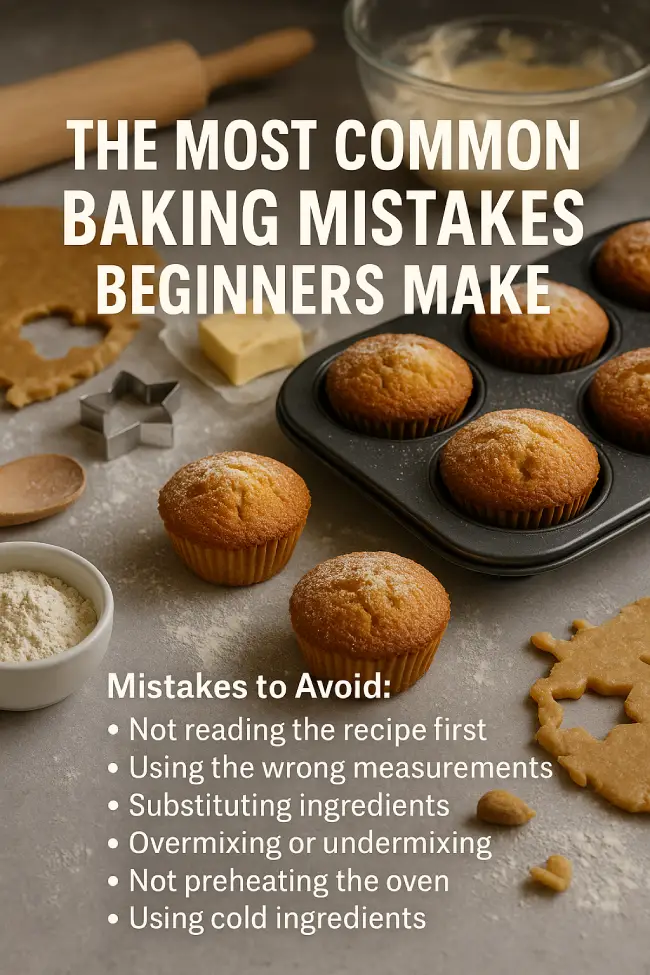Learning to bake can be one of the most rewarding hobbies, but it also comes with a learning curve. Many beginners make the same mistakes, often leading to undercooked centers, rock-hard cookies, or flat cakes.
But don’t worry—most baking mistakes are completely avoidable once you know what to look out for.
In this article, we’ll break down the most common baking blunders and teach you how to avoid them so that your journey in the world of sweets can be much smoother—and tastier.
Mistake #1: Not Reading the Entire Recipe First
One of the most common issues among new bakers is starting a recipe without reading it all the way through.
Why it matters:
You may miss crucial steps like chilling the dough or preheating the oven. Some ingredients might need to be at room temperature or melted beforehand.
Solution:
Always read the full recipe before starting. Understand the steps, check you have all ingredients, and prepare what you can in advance (a method known as mise en place).
Mistake #2: Using the Wrong Measurements
Baking is more science than art. Using too much flour or too little baking powder can completely ruin a dessert.
Common measurement issues include:
-
Scooping flour with a cup (which compacts it) instead of spooning it in and leveling off.
-
Confusing teaspoons (tsp) with tablespoons (tbsp).
-
Not using liquid measuring cups for wet ingredients.
Solution:
Invest in basic measuring tools and follow measurements exactly. A digital scale is great but not required at first.
Mistake #3: Substituting Ingredients Without Understanding Their Function
Substituting ingredients randomly is risky in baking. Replacing baking soda with baking powder, or butter with margarine, can drastically change the final product.
Why it’s a problem:
Each ingredient plays a specific role—flour builds structure, eggs bind, sugar sweetens and browns, and fat adds tenderness.
Solution:
Only substitute ingredients when the recipe specifically allows or if you understand how substitutions will affect the chemistry.
Mistake #4: Overmixing or Undermixing
Mixing develops gluten, which affects the texture of your baked goods.
-
Overmixing cake or muffin batter can make it tough and dense.
-
Undermixing leaves pockets of dry flour and uneven texture.
Solution:
Mix just until ingredients are combined. For cakes and muffins, stop as soon as the batter looks uniform.
Mistake #5: Not Preheating the Oven
Your oven should always be hot and ready before you place anything inside.
Why it matters:
Most baked goods need a strong initial blast of heat to rise properly. A cold oven can lead to flat, dense results.
Solution:
Preheat your oven for at least 15–20 minutes before baking. Use an oven thermometer if your appliance is unreliable.
Mistake #6: Opening the Oven Door Too Often
It’s tempting to check on your masterpiece every few minutes—but opening the oven causes heat loss and disrupts baking.
Why it’s risky:
Sudden temperature drops can make cakes sink and cookies bake unevenly.
Solution:
Only open the oven when necessary, and ideally wait until at least 80% of the baking time has passed.
Mistake #7: Using Cold Ingredients When Room Temperature is Required
Many recipes require room temperature eggs, butter, or milk to blend properly.
Why it matters:
Cold ingredients don’t emulsify well, leading to lumpy batter or curdled mixtures.
Solution:
Take ingredients out of the fridge 30–60 minutes before baking. If you forget, warm eggs in warm water and soften butter in short microwave bursts (with caution).
Mistake #8: Not Letting Baked Goods Cool Properly
Pulling your dessert out of the oven is exciting, but rushing to slice or decorate it can ruin the texture or appearance.
Why it matters:
Baked goods continue to cook slightly as they cool and need time to firm up. Cutting too soon can lead to crumbling or soggy centers.
Solution:
Follow cooling instructions exactly. Use cooling racks to prevent soggy bottoms.
Mistake #9: Ignoring Your Oven’s Hot Spots
Many ovens have uneven heat zones. This can cause cookies to brown more on one side or cakes to bake unevenly.
Solution:
Rotate your pan halfway through the baking time. Test your oven’s hot spots by placing bread slices on the rack and seeing which browns first.
Mistake #10: Not Testing for Doneness Properly
Relying only on baking time can be misleading, especially if your oven runs hot or cold.
Common signs of doneness:
-
A toothpick inserted comes out clean or with a few moist crumbs.
-
The center of the cake springs back when gently pressed.
-
Cookies have golden edges and look slightly underbaked in the center—they’ll continue baking from residual heat.
Solution:
Learn the visual and physical cues for doneness rather than relying only on time.
Bonus Mistake: Trying to Be Too Perfect
Many beginners compare themselves to professional bakers or Instagram photos. This pressure can lead to disappointment or fear of failing.
Truth:
Everyone burns a batch or forgets an ingredient sometimes. That’s how you learn.
Solution:
Celebrate the small wins and laugh at the flops. Every mistake makes you a better baker.
Final Thoughts: Progress Over Perfection
Baking is a journey, and mistakes are a natural part of learning. By understanding these common pitfalls, you can avoid frustration and gain confidence in your skills. Keep practicing, stay curious, and enjoy the process as much as the sweet results.
Your future self will thank you—especially when you’re pulling a perfectly risen cake out of the oven with a proud smile on your face. 🍰

